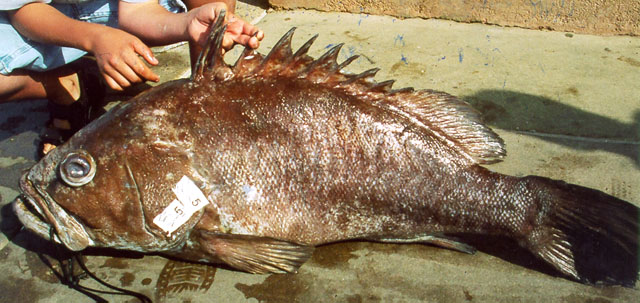| Epinephelidae (Groupers) |
| 100 cm TL (male/unsexed); max.weight: 22 kg |
|
demersal; marine; depth range 40 - 120 m |
| Eastern Pacific: Galapagos Islands, Isla del Coco, and off Costa Rica. It probably occurs off Mexico. Galapagos Islands subpopulation is classified as vulnerable in the 2004 IUCN red list of threatened species (Ref. 53964). |
|
Dorsal spines (total): 11-11; Dorsal soft rays (total): 14-16; Anal spines: 3-3; Anal soft rays: 9-9. Distinguished by the following characteristics: head and body pale brown, with distinct greenish sheen on the body; dark color of lips, tip of lower jaw and dorsal part of the body; brown fins, darker than body, with blue-green sheen; pelvic fins pale brown with dusky membranes; juveniles without distinctive markings except for a dark maxillary groove; body depth 2.6-3.0 times in SL; head length 2.5-2.8 times in SL; convex interorbital area, width greater than eye diameter; preopercle subangular, serrae at angle slightly enlarged; slightly convex upper edge of operculum; subequal nostrils or posterior nostril slightly larger; maxilla reaches past vertical through centre of eye; midside of lower jaw with two rows of teeth; truncate caudal fin with rounded corners in adults, convex in juveniles; midlateral body scales distinctly ctenoid, auxiliary scales in large adults (Ref. 089707). |
| Deep-water species found on rocky reefs in depths of 40-120 m (Ref. 089707). Marketed fresh (Ref.9342). |
|
Least Concern (LC); Date assessed: 21 November 2016 Ref. (130435)
|
| harmless |
Source and more info: www.fishbase.org. For personal, classroom, and other internal use only. Not for publication.

